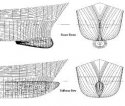by78
General
this is not a complete section ? or reflect the current status ?
It's a photoshopped image that digitally reduced the gaps between all the modules to give an idea of what they would look like if they had all been welded together.
this is not a complete section ? or reflect the current status ?
the fact that cargo ship tend to be lopsided general,y has little to do with speed. It has to do with the fact that cargo ships operate at either nearly fully laden, or in ballast. The bulb is designed to produce the most benefit when the ship operates at laden draft, but must not produce too much excess wave and drag when the ship is in ballast and parts of the bulb is above water plowing a furrow of its own.Bulb shape is determined by mission profile and the full use of the ship. Commercial ship hulls don't have the same shape as warship hulls, along with the fact that commercial ship hulls, in this case, freighters, box ships, tankers, bulkers and that like, are almost always operating at full.
View attachment 62914View attachment 62915View attachment 62916
Contrast that to warship bulbs.
View attachment 62917
View attachment 62918
View attachment 62919
the fact that cargo ship tend to be lopsided general,y has little to do with speed. It has to do with the fact that cargo ships operate at either nearly fully laden, or in ballast. The bulb is designed to produce the most benefit when the ship operates at laden draft, but must not produce too much excess wave and drag when the ship is in ballast and parts of the bulb is above water plowing a furrow of its own.
But that is not the only reason why a bulb may be designed to be lopsided. Thee are instances of Large fast ships designed to operate with a very narrow range of drafts, and the bulb will almost always be submerged just like on a aircraft carrier, that also has lop sided bulbs. For example the 29 knot cruise ship/ocean liner Queen mary 2 has a distinctly lopsided, upswept bulb.
So analysis by analogy can’t provide definitive conclusions.





Again, The bulb on box ships point upward, and tend to have a rather sharp prowl of its own, because the bulb must provide the maximum benefit when it is submerged When the ship is at deep load, but must not create too much Additional drag cutting through the surface of the water when it is partly exposed at shallow draft. However, the fact QM2, a ship of broadly similar size, similar top speed as a large Aircraft carrier, and also Designed to operate within a narrow range of draftS just like an large aircraft carrier, suggests the aysymmetry of the bulb is not diagnostic of whether the hull it is attached to is meant to be operated in a manner consistent with a carrier.






Entirely on the contrary, commissioned warships only ever operate at or near full load displacement. If they use up consumables And
become lighter, they take on water ballast maintain theOr near maximum displacement. Their underwater damage resistance is usually calculated to be at maximum at their designed combat displacement. Look at the boot top of warships. You never see the commissioned
warships ridding high with their boot top much farther than normal above water.
A similar state does apply to passenger ships, such as cruise ships and ocean liners. They also ballast down when lightened by usage of consumables such as fuel, this is why you also never seem the riding high in the water with boot top conspicuously high above actual waterline.
Many box ships, on the Hand, do operate very light much more often, such as when transiting between different service route.
That’s a good point. A Chinese paper from 2013 described an optimized Kitty Hawk hull. Same block coefficient of 0.58, but longer with a waterline length of 319.2m (more than a Nimitz) and a displacement of 85.4kt. The waterline beam was kept the same at 39.4m.A ship’s length and beam, and even draft, offers a relatively poor indicator of its displacement. It’s underwater shape, partially encapsulated in block coefficient, can make the displacement quite different for the same dimensions. Block coefficient measure a hull’s true displacement as a fraction of the displacement of a box with the same overall length, width and depth. In general, a ship with low block coefficient, or smaller displacement for it’s dimension, tend to be Hydrodynamical more efficient. At the same time, it is easier to work in better stability, extensive watertight compartmentalisation, and great depth of protection Against underwater attack in a ship which high block coefficient. However, high block coefficient can also be an indication the ship is constrained in allowable maximum length, beam and draft. Recent US carriers all tend to have high block coefficients because limitations of existing naval docking facilities that dates from WWII limit the extent to which length and beam of US carriers can increase. No doubt the US would have made the Nimitz longer and Beamier for the same displacement had the docking restriction been removed.
So, unless for some reason the Chinese have similar docking restrictions as the USN, I would expect if a Chinese carrier has the same displacement as the Nimitz, then the Chinese carrier would be somewhat longer and beamier, possibly deeper draft, than the Nimitz, but have a finer underwater hull shape.
conversely, if the Chinese carrier has the same length, beam and draft as the Nimitz, the Chinese carrier would have significantly less displacement, thanks again to a finer underwater hull shape.
